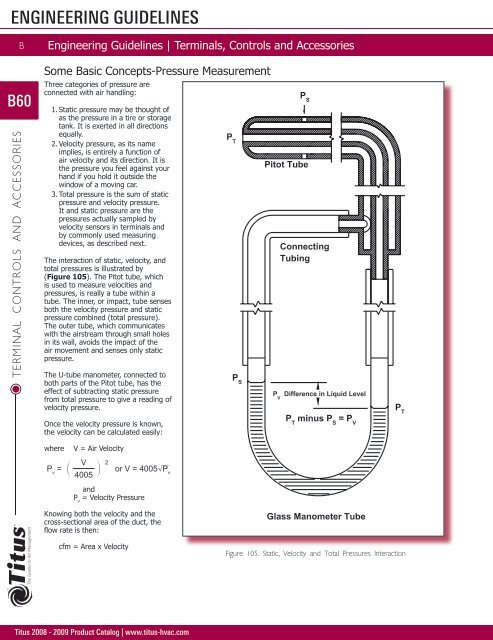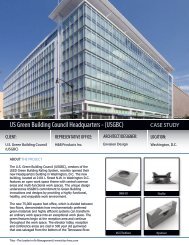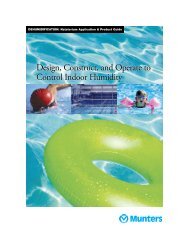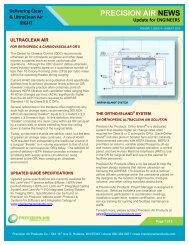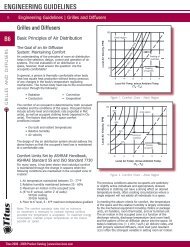Titus 2008 - 2009 Product Catalog | www.titus ... - Texas Air Products
Titus 2008 - 2009 Product Catalog | www.titus ... - Texas Air Products
Titus 2008 - 2009 Product Catalog | www.titus ... - Texas Air Products
Create successful ePaper yourself
Turn your PDF publications into a flip-book with our unique Google optimized e-Paper software.
ENGINEERING GUIDELINES<br />
B<br />
B60<br />
TERMINAL CONTROLS AND ACCESSORIES<br />
Engineering Guidelines | Terminals, Controls and Accessories<br />
Some Basic Concepts-Pressure Measurement<br />
Three categories of pressure are<br />
connected with air handling:<br />
1. Static pressure may be thought of<br />
as the pressure in a tire or storage<br />
tank. It is exerted in all directions<br />
equally.<br />
2. Velocity pressure, as its name<br />
implies, is entirely a function of<br />
air velocity and its direction. It is<br />
the pressure you feel against your<br />
hand if you hold it outside the<br />
window of a moving car.<br />
3. Total pressure is the sum of static<br />
pressure and velocity pressure.<br />
It and static pressure are the<br />
pressures actually sampled by<br />
velocity sensors in terminals and<br />
by commonly used measuring<br />
devices, as described next.<br />
The interaction of static, velocity, and<br />
total pressures is illustrated by<br />
(Figure 105). The Pitot tube, which<br />
is used to measure velocities and<br />
pressures, is really a tube within a<br />
tube. The inner, or impact, tube senses<br />
both the velocity pressure and static<br />
pressure combined (total pressure).<br />
The outer tube, which communicates<br />
with the airstream through small holes<br />
in its wall, avoids the impact of the<br />
air movement and senses only static<br />
pressure.<br />
The U-tube manometer, connected to<br />
both parts of the Pitot tube, has the<br />
effect of subtracting static pressure<br />
from total pressure to give a reading of<br />
velocity pressure.<br />
Once the velocity pressure is known,<br />
the velocity can be calculated easily:<br />
where V = <strong>Air</strong> Velocity<br />
P = o<br />
v V p<br />
4005<br />
and<br />
P v = Velocity Pressure<br />
Knowing both the velocity and the<br />
cross-sectional area of the duct, the<br />
flow rate is then:<br />
cfm = Area x Velocity<br />
<strong>Titus</strong> <strong>2008</strong> - <strong>2009</strong> <strong>Product</strong> <strong>Catalog</strong> | <strong>www</strong>.<strong>titus</strong>-hvac.com<br />
2<br />
or V = 4005√P v<br />
P T<br />
P S<br />
P S<br />
Pitot Tube<br />
Connecting<br />
Tubing<br />
P V Difference in Liquid Level<br />
P T minus P S = P V<br />
Glass Manometer Tube<br />
P T<br />
Figure 105. Static, Velocity and Total Pressures Interaction


